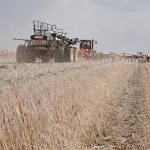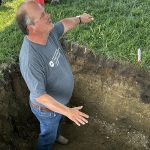Les Henry Award winner Jeff Schoenau from the U of S looks back on the lessons passed down from his late teacher
LANGHAM, Sask. — Standing in a soil pit at the Ag In Motion outdoor farm show near Langham July 17, University of Saskatchewan soil scientist Jeff Schoenau entertained and educated a crowd of about 50 people with the basics of soil science. Schoenau waved his arms around, dug into the soil layers with a knife […] Read moreTag Archives soil science

U.S to incentivize climate friendly farming
Farmers offered money to adopt practices that store carbon in the soil, but experts doubt the approach will be effective
WASHINGTON (Reuters) — President Joe Biden’s administration is offering farmers money to adopt practices that store carbon in the soil to fight climate change, but soil science experts and a review of U.S. Department of Agriculture research indicate doubt that the approach will be effective. Planting cover crops and reducing tillage are key to the […] Read more
Pipelines may have long-term consequences for crop yields
British Columbia farmers with pipelines running under their land have complained that compensation runs out long before yields return to normal. New findings from a University of Manitoba researcher suggest they may be right. “Farmers believe … they are really being short-changed,” said Francis Zvomuya, a professor of soil science at the university. During a […] Read more

Scientists figure out how to farm on the moon
Research conducted in China shows how lunar soil can be made fertile enough to support agricultural production
WASHINGTON, D.C. (Reuters) — If humankind is ever to establish long-term bases on the moon, there will be a need for a regular source of food. It is not practical, however, to think you can plant corn or wheat in plain lunar soil in greenhouses on the moon and expect a bumper crop, or any […] Read more





